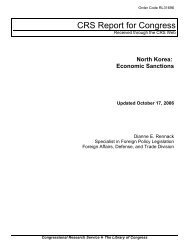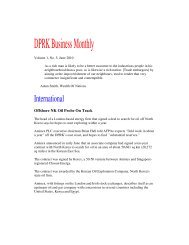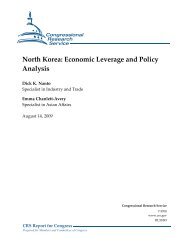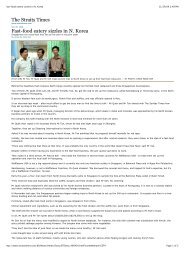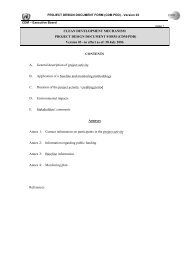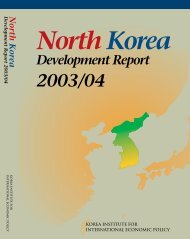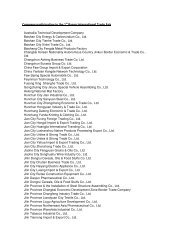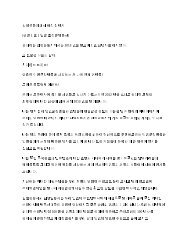North Korean Policy Elites - Defense Technical Information Center
North Korean Policy Elites - Defense Technical Information Center
North Korean Policy Elites - Defense Technical Information Center
You also want an ePaper? Increase the reach of your titles
YUMPU automatically turns print PDFs into web optimized ePapers that Google loves.
The primary missions of the Reconnaissance Bureau are the collection of tactical and<br />
strategic intelligence within the military sphere, and strategic special operations throughout the<br />
ROK and overseas. It is organized into a headquarters, Political Department, Intelligence<br />
Department, Special Department, <strong>Technical</strong>/Radio Department, Training/Plans Department,<br />
Maritime Department, and five Reconnaissance Battalions. Additionally, the Reconnaissance<br />
Bureau is believed to operate a small number of Trading Companies as “covers” and to generate<br />
financing for operations. 13<br />
Subordinate to the MPAF is the Guard Command, which is responsible for the personal<br />
security of Kim Chong-il and high-ranking officials. Although it is roughly comparable to the<br />
U.S. Secret Service or the ROK Office of Presidential Security, it also possesses a small number<br />
of combat units. In the performance of its mission, it works closely with the State Security<br />
Department and, to a lesser degree, the P’yongyang <strong>Defense</strong> Command. 14<br />
Although institutionally subordinate to the MPAF, the Security Command is controlled<br />
by the State Security Department. This organization is responsible for internal security within the<br />
KPA. 15 The State Security Department functions both as an intelligence agency engaged in<br />
active operations overseas and as a domestic political security force (i.e., secret police). It is most<br />
comparable in function to the former Soviet KGB or, to a lesser degree, the ROK National<br />
Intelligence Service (formerly National Security Planning Agency). It is responsible for security<br />
(physical and political) within the DPRK’s embassies, missions, and legations located<br />
throughout the world. The State Security Department and the Guard Command are the agencies<br />
most directly responsible for the security of Kim Chong-il and reportedly only he is exempt from<br />
their scrutiny. Following the Constitutional amendments of September 1998, the State Security<br />
Department was subordinated to the National <strong>Defense</strong> Commission. 16<br />
13<br />
14<br />
15<br />
16<br />
Author Interview data and “DPRK Spy Organizations Targeting Japan,” Gunji Kenkyu, June 1999, pp. 68-73, as<br />
cited in FBIS.<br />
Author interview data; “Monthly Discusses Secret Works in DPRK,” Pukhan, 12 January 1999, pp. 72-83, as<br />
cited in FBIS-EAS-99-012; “Kim Chong-il’s Security Force Strengthened,” Naewoe Tongsin, No. 961, 13 July<br />
1995, pp. E1-E4, as cited in FBIS-EAS-95-182; and “Journal Views DPRK’s Military Organization,” pp. 30-31.<br />
Author interview data; “DPRK’s Kim Chong-il’s Position on Retaliation,” pp. 8-11; “Generational Shift in<br />
DPRK Leadership Gaining Momentum,” Hanguk Ilbo, 29 July 1996, p. 13, as cited in FBIS-EAS-96-146;<br />
“Defector to ROK on Kim Chong-il’s Control of DPRK Military,” pp. 161-167; “Defector Hwang Chang-yop<br />
[Hwang Jang Yop] Interviewed,” pp. 328-345; “Defector Says KPA Under ‘Complete Control’ of Kim Chongil,”<br />
Seoul Sinmun, February 26, 1996, p. 2, as cited in FBIS-EAS-96-039; “Articles by Defector Kang Myong-to<br />
Reported,” p. 3; and “Journal Views DPRK’s Military Organization,” pp. 30-31.<br />
Author interview data; “NK Reshuffles Political Structure;” A Handbook on <strong>North</strong> Korea, p. 20; “Attempted<br />
1995 Military Coup d’Etat in DPRK Alleged,” Chugan Choson, March 21, 1996, pp. 34-35, as cited in FBIS-<br />
EAS-96-053; “Article on Past Military Coup Attempts in <strong>North</strong>,” Iryo Sinmun, 21 May 1995, p. 9, as cited in<br />
FBIS-EAS-95-097; “DPRK ‘Intensifying’ Internal Control,” Seoul Sinmun, 6 May 1996 p. 2, as cited in FBIS-<br />
EAS-96-088; and “Journal Views DPRK’s Military Organization,” pp. 30-31.<br />
I-12



